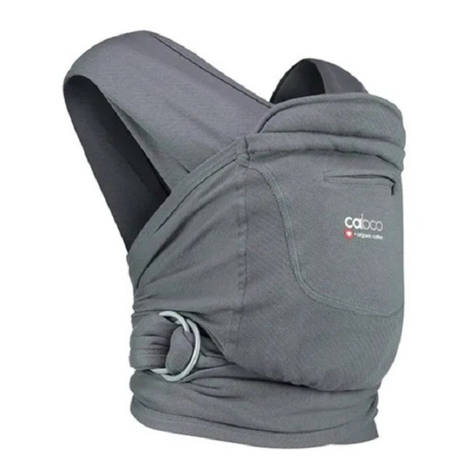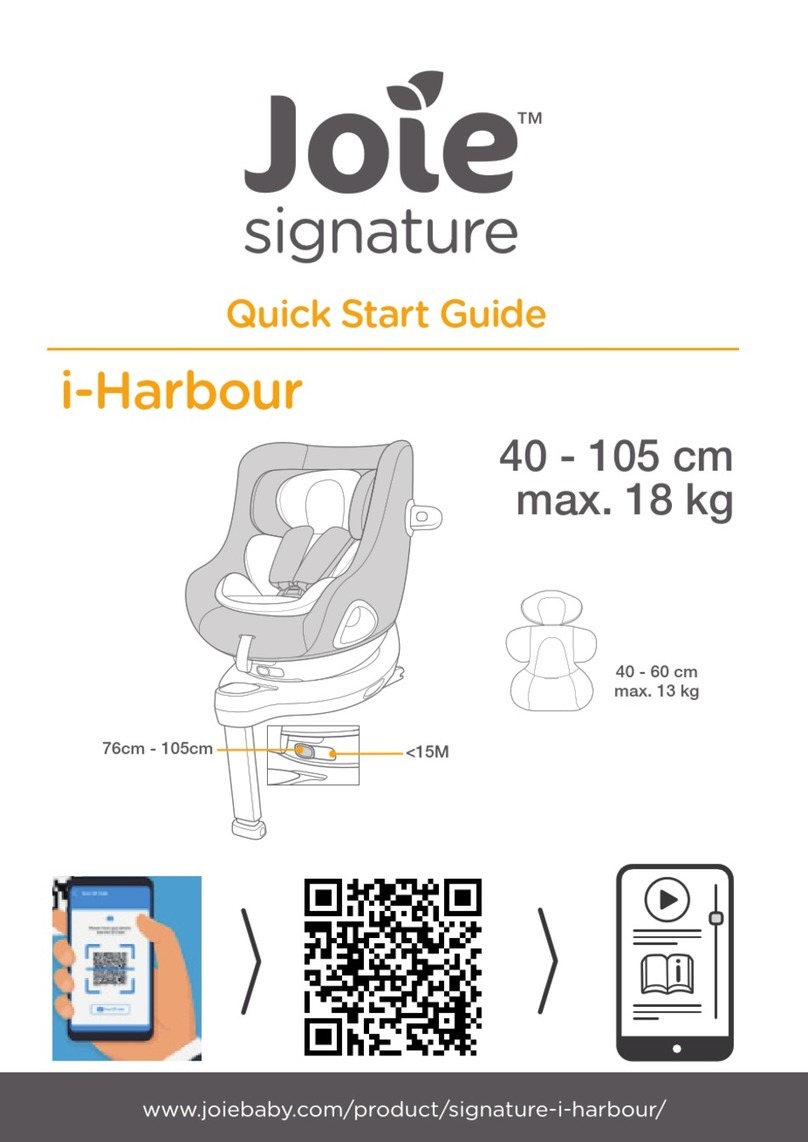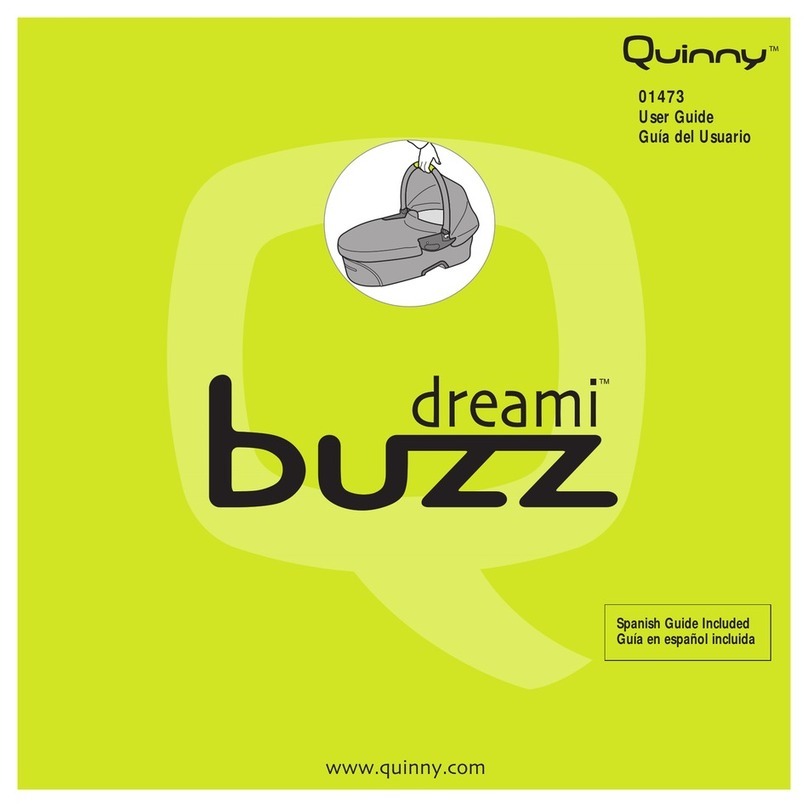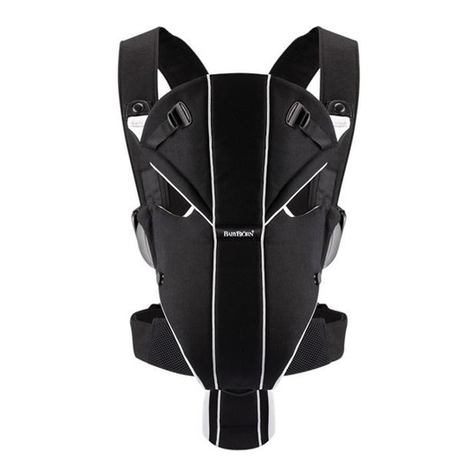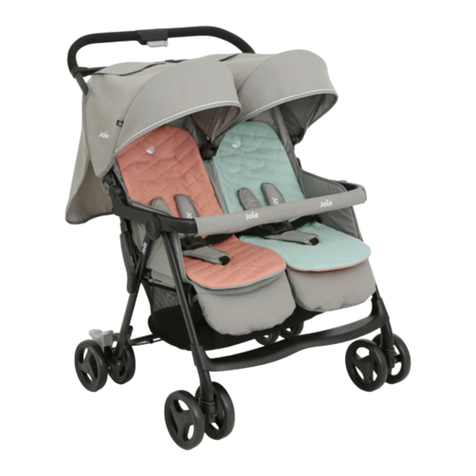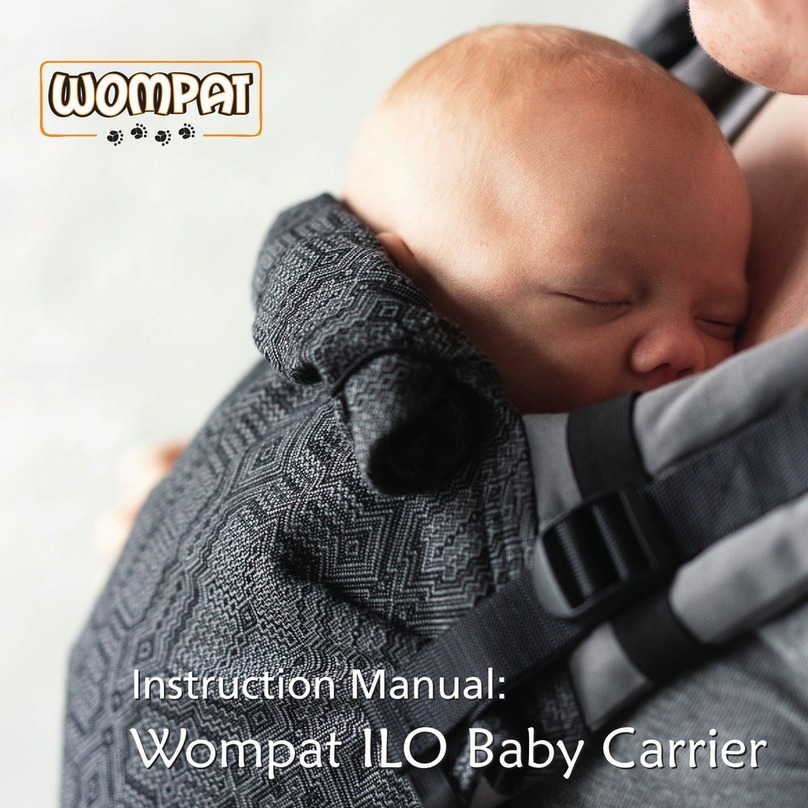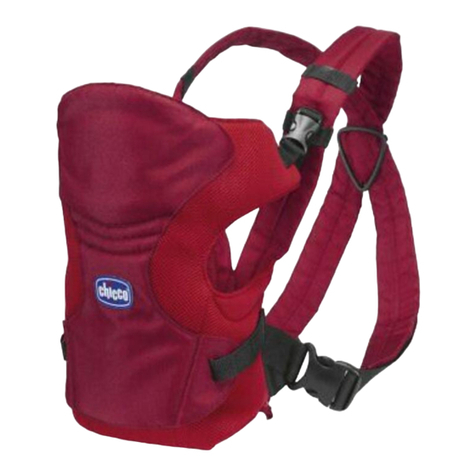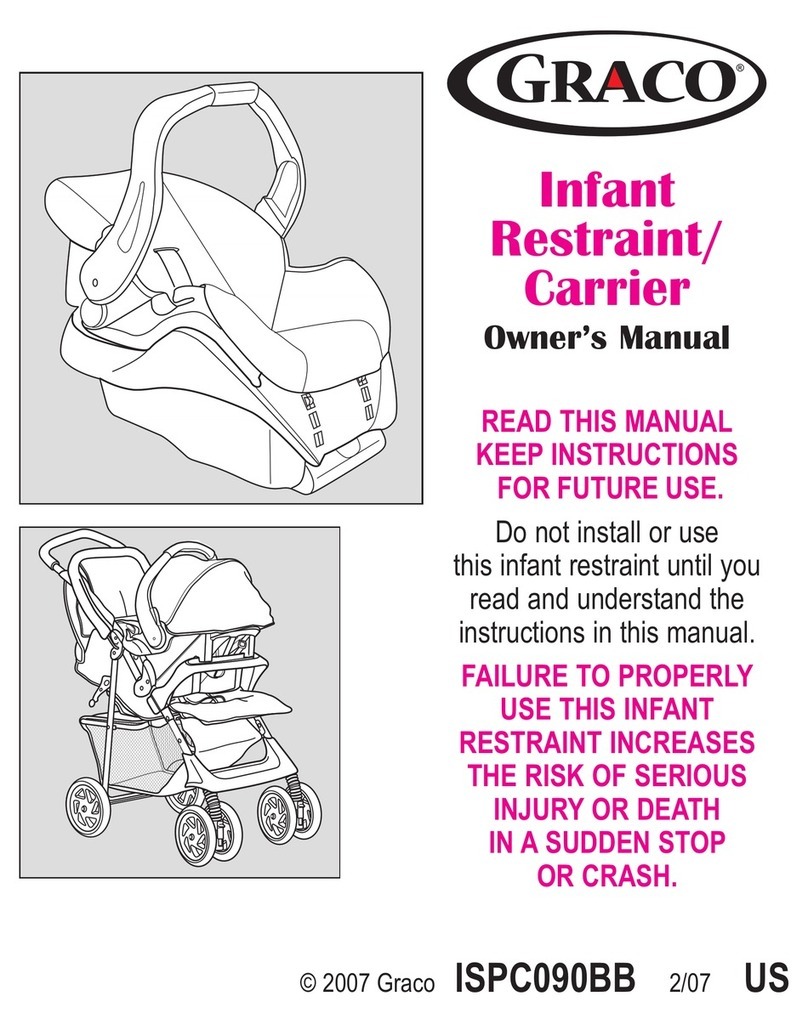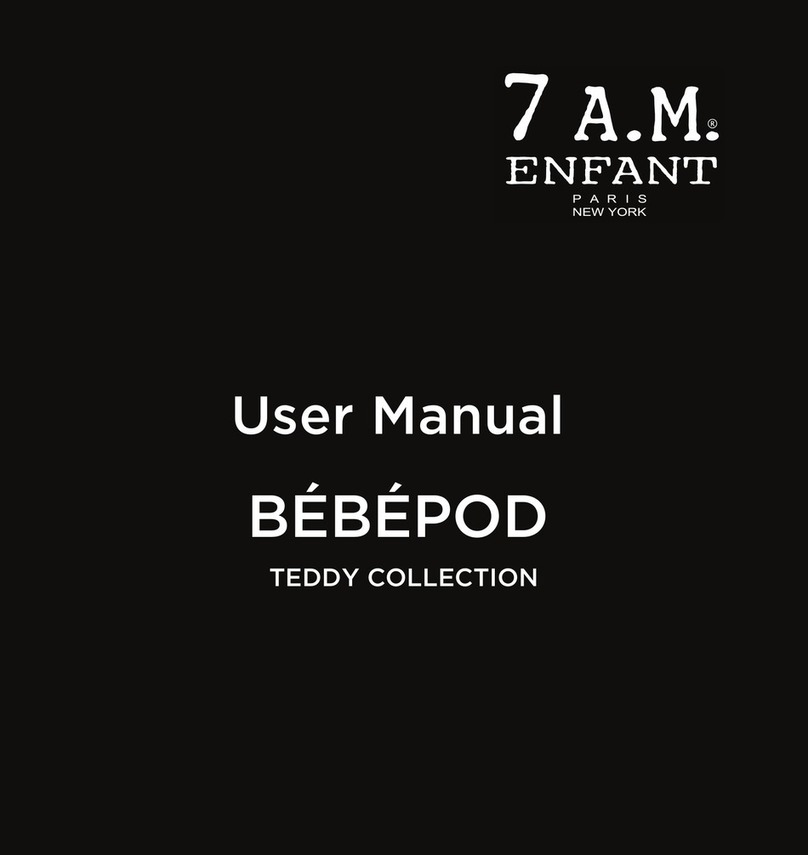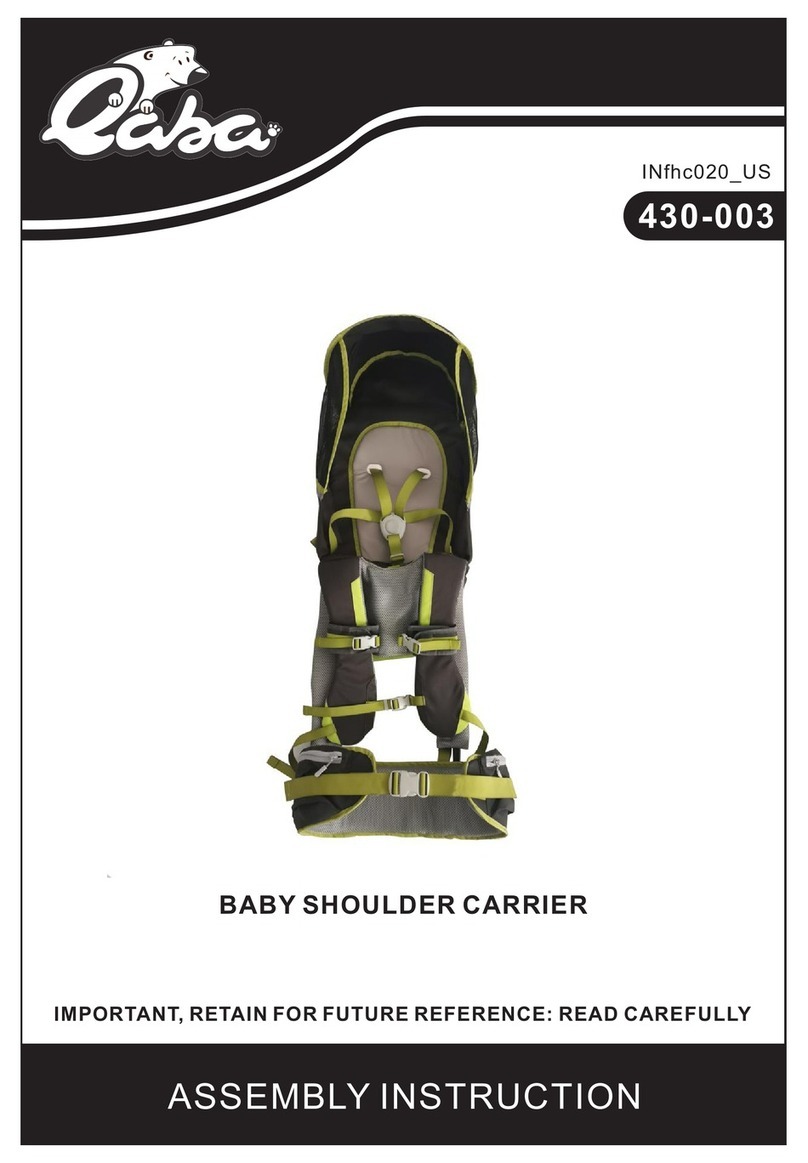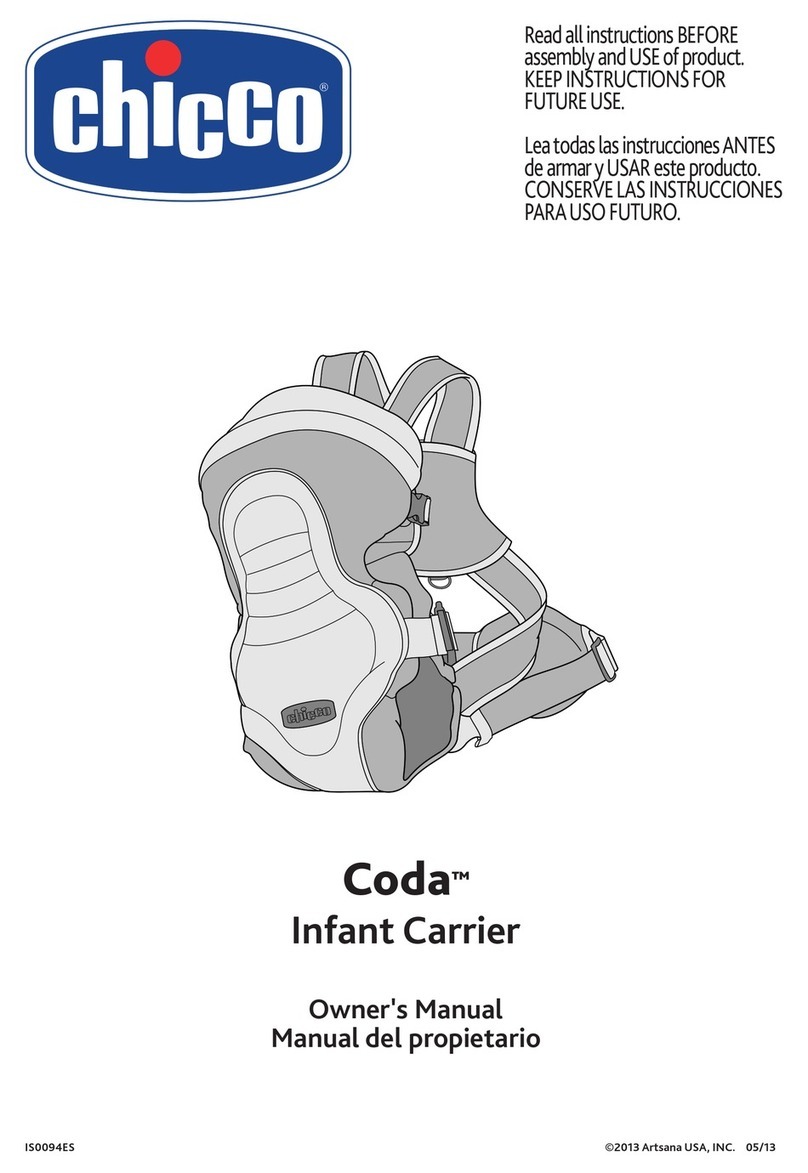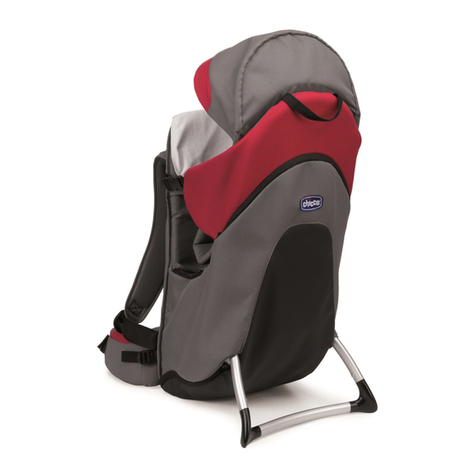Close Parent Caboo dx+ User manual

good ideas for great parents
USER INSTRUCTIONS
Min 5lbs/ 2.3kgs Max 32lbs / 14.5kgs
DX instructions.indd 1 21/04/2015 13:06

www.closeparent.com
Parts of my Caboo dx+
1. Hammock 2. Main pod 3. Removable head support 4. Back/lumbar support
5. Main rings 6. D rings 7. Adjustable bottom strap 8. Shoulder straps
9. Side straps 10. Thermo regulating panel 11. Waist buckle
12. Top rail of hammock 13. Bottom rail of hammock 14. Loop for buckle
Adjusting your pod...
position 1 position 2 position 3
12.
1.
13
3.
2.
11.
5.
6.
9. 9.
7.
forward facingparent facing
position 4
14.
8.
10.
4.
DX instructions.indd 2 21/04/2015 13:06

good ideas for great parents
Always Caboo safely…
Please take the time to read through all of the instructions before using your Caboo dx+, we would ask you to pay
special attention to the safety precautions and warnings below, these are designed to ensure safe carrying at all times,
you can view a copy of the T.I.C.K.S guidelines for safe carrying in full on our website www.closeparent.com.
With practice it will be second nature for you to Caboo, but in the meantime you can practice with a soft
toy or doll in front of the mirror to build up your condence! Download the video demonstration from
www.closeparent.com before you start!
Safety precautions
• Make sure baby is in view at all times…regularly check your baby is secure and happy
• Keep baby high up on your chest… close enough to kiss
• Keep baby’s chin off their chest…at least 1cm gap for free owing air
• Baby should be held comfortably close…and fully supported. You should be able to maintain visual contact with your
baby at all times when being carried
• Make sure baby is central…and the cross section is spread out under their bottom knee to knee
• Don’t overdress your baby… remember your body heat will keep them warm so dress them down a layer and never
cover baby’s head or face with an item of your own clothing.
• Use common sense… don’t engage in activities which may expose you or your baby to unnecessary danger or risk…
hot food or drink, heat sources, handling knives or operating dangerous machinery
• Only carry one child at a time in this carrier
• Please be aware of the increased risk of your child falling out of the carrier as it becomes more active
• Regularly inspect your carrier for any signs of wear and damage
• Keep this carrier away from children when it is not in use
WARNINGS
• HAMMOCK SHOULD NEVER BE USED ALONE WITHOUT THE MAIN POD
• TAKE CARE WHEN BENDING AND LEANING FORWARDS OR SIDEWAYS, ALWAYS SUPPORT BABY
• NEVER ALLOW YOUR BABY’S FACE TO BE COVERED
• THIS CARRIER IS NOT SUITABLE FOR USE DURING SPORTING ACTIVITIES E.G. RUNNING, CYCLING, SWIMMING & SKIING.
• YOUR MOVEMENT AND THE CHILD’S MOVEMENT MAY AFFECT YOUR BALANCE.
• CONSTANTLY MONITOR YOUR CHILD AND ENSURE THE MOUTH AND NOSE ARE UNOBSTRUCTED.
• FOR PRE-TERM, LOW BIRTHWEIGHT BABIES AND CHILDREN WITH MEDICAL CONDITIONS, SEEK ADVICE FROM A
HEALTH PROFESSIONAL BEFORE USING THIS PRODUCT.
• ENSURE YOUR CHILD’S CHIN IS NOT RESTING ON ITS CHEST AS ITS BREATHING MAY BE RESTRICTED WHICH COULD
LEAD TO SUFFOCATION.
• TO PREVENT HAZARDS FROM FALLING ENSURE THAT YOUR CHILD IS SECURELY POSITIONED IN THE CARRIER.
IMPORTANT!
PLEASE KEEP FOR FUTURE REFERENCE
DX instructions.indd 3 21/04/2015 13:06

www.closeparent.com
Washing Instructions
Handy tip …
Tie your Caboo dx+ inside a pillowcase when washing to keep the rings away from the machine
drum and reduce the noise. *Close accepts no responsibility for individual appliances.
Before you start:
You will need to thread the waist buckles onto the ends of the hammock fabric...
Fig. A1 – Thread one end of the hammock fabric strap through both D rings of the buckle and
then bring it back again through the top ring. Repeat with the other strap.
If you need to thread the main rings before use…
Fig B.1 – Take the hammock and place it over your shoulders, lumbar support to the back.
Fig B.2 - Take the strap over your left shoulder across your body and thread through both rings
- make sure you are threading it through the main metal rings and not the smaller D rings
Fig B.3 - Then take the end of the strap and thread it back through the front/top ring. To test
whether you have threaded them correctly pull on the fabric behind the rings…it should stay
rmly in place. Then repeat with the opposite strap and go straight to Fig A.5 and follow the
steps from there.
How and when to adjust the bottom strap on the Pod…
There are multiple positions for the bottom strap which can be adjusted according to size of
baby and carrying position. The strap simply poppers onto the bottom of the main Pod and
adjusts at either side (see inside page for image referances to pod settings).
Position 1 - Smallest size setting facing in Position 2 -Second size setting facing in
Position 3 - Smallest size setting facing forward Position 4 – Second size setting facing forward
Hammock: wash at 30° and do not
tumble dry (do not iron back panel)
Pod: wash at 30°, do not tumble
dry and do not iron !
DX instructions.indd 4 21/04/2015 13:06

good ideas for great parents
Putting on your Caboo dx+
Fig A.2 - Make sure the side straps are loosened off rst and nothing is twisted. Hold the
hammock out in front of you as shown…the logo should be facing you reading the right way up.
Fig A.3 - Place the hammock over your head like a T-shirt…your arms should go out through the
sides and head through the middle.
Fig A.4 - Pull the lumbar support down at the back ensuring that the straps aren’t twisted…
the bottom of the lumbar support should sit comfortably in your mid to low back.
Fig A.5 - Tighten the hammock at the front by pulling the straps at each side down and forward
evenly, leaving just enough room to get your baby in...it is important that it’s not too loose, baby
should be comfortably close (see handy tips below)
Fig A.6 - To check the tightness of the hammock, simply place your hands behind the straps as
shown, you should be able to stretch the fabric approximately 10-12cm clear from your chest,
no more. Take some time to identify the inner strap; this is the strap that runs closest to your
body, the other is referred to as your outer strap.
Fig A.7 - To loosen the hammock at any time lift the visible front/top ring at each side up and
outwards and pull the fabric to lengthen the strap.
Handy tips; If you are unsure whether the carrier is tight enough you can use this test. Gently
press the palm of your open hand across baby’s back, there should be very little movement if it
is correctly tightened. You should also be able to kiss the top of baby’s head very easily.
DX instructions.indd 5 21/04/2015 13:06

www.closeparent.com
Positions 0-3 months
Weight range 5lbs – 2.3kg+
Upright Newborn position…
Fig C.1 - Always check you have left 10-12 cm space between you and the hammock.
Fig C.2 - Pick baby up and support them with one hand high up on your shoulder on the outer
strap side. Use your free hand to reach under the top part of the inner strap and guide your
baby’s leg through.
Fig C.3 - Transfer your baby to the opposite shoulder supporting their head and bring the other
leg through the outer strap.
Fig C.4 - Lower baby’s bottom down inside the cross created by the straps making sure the
straps of the cross are located behind baby’s knees. Spread the straps (inner strap rst)
making sure the thermo regulating panels are facing in towards baby. The straps should be
spread fully and evenly from behind baby’s knee all the way across baby’s back and shoulders
to the back of their other knee so they sit in the ‘Frog legged’ or ‘M’ position...ie with their knees
higher than their bottom. If you nd the top or bottom rail is gaping simply follow either rail to
the ring and pull through the ring section to tighten. Tilt baby’s head back and lay baby’s cheek
against your chest to ensure they have free owing air… their chin should be clear of their chest by
a minimum of 1.5 ngers. Then support baby’s head by simply spreading the fabric from the
shoulder closest to them behind their head…it is good to do this with a baby of any age while
they sleep. The straps of the hammock may be further tightened if necessary at this point.
Fig C.5 – C.6 - Pick up the Pod at the bottom and hold it around baby. Push up under baby’s
bottom, so the velcro dot catches the tricot panel on the hammock. Then holding the Pod in
place against baby with one hand, bring the side strap forward and clip to the Pod at each
side with the other. Once clipped tighten each side evenly by pulling the strap forwards, making
sure the Pod stays central and straight. The top of the Pod should be pulled up to sit around the
nape of baby’s neck.
DX instructions.indd 6 21/04/2015 13:06

good ideas for great parents
Once in place, bring the waist buckles of the hammock through the belt loop at the bottom of
the Pod and clip together, this will keep the Pod in place. Pull on the ends of the hammock straps
to tighten.
Please note: The additional head support Pod is designed to be used once baby can
fully support their own head around 4-5 months so is not needed in this position. In those rst
formative few months baby’s head should always be supported cheek to chest by one of the
hammock straps as this allows better airow.
Handy tip: If you’ve had a c-section, you may nd it more comfortable to leave the hammock
unclipped, without the buckles on, and simply tie the ends of the straps loosely underneath
baby, if you do this you will need to simply fold up the bottom ap of the Pod between you and
baby to keep it in place.
Taking baby out and taking off your
Caboo dx+…
Unclip the side buckles and take off the Pod, (*or you can simply undo one side only and let one
side hang down if putting baby back in soon) unclip the front waist buckle and loosen the rings
slightly to release the fabric if needed, support your baby with one hand while you pull the fabric
back with the other until you can get your hands under each arm (and cupped behind the head
for a newborn) then simply lift baby up and away from you to free the legs. Put baby down safely,
then to take off your Caboo simply run your hands down under the lower straps of the hammock
and take off over the head.
DX instructions.indd 7 21/04/2015 13:06

www.closeparent.com
AA B
C
E F
G
D
D D
D
DX instructions.indd 8 21/04/2015 13:06

good ideas for great parents
AA B
C
E F
G
D
D D
D
DX instructions.indd 9 21/04/2015 13:06

www.closeparent.com
Upright facing in
*for babies who can hold their own head around 4 months +
Popper the additional head support onto the main Pod and check the bottom strap on the Pod
is still on the correct size setting or adjust if necessary (‘adjusting your pod’ guide can be found
on page 2).
Fig D.1 to D.4 Put your Caboo dx + on as before... baby goes into the hammock in the same way
(Fig C1:C6) however now baby’s arms do not need to be contained by the strap because your
baby has additional support from the Pod. Note that the Pod should come at least half way up
the back of baby’s head.
D5.- Secure the top of the additional head support at either side by attaching to the
shoulder straps located on the hammock. Once the Pod is in place, bring the waist buckles of the
hammock through the belt loop at the bottom of the Pod and clip together. Pull on the ends of
the hammock straps to tighten.
Handy tip; try tucking one or both arms under the hammock straps while baby sleeps.
We recommend you always use the additional head support at this age if baby is sleeping, you
can undo the shoulder strap at one side to increase air ow while baby’s head is cheek to chest.
Ensure baby’s head is tilted back slightly for best air ow.
DX instructions.indd 10 21/04/2015 13:06

good ideas for great parents
Upright facing out
*for babies with excellent head control 5+ months
Fig E.1 to E.3 – Put Caboo dx+ on as before... making sure you loosen off the side straps, and
baby goes into the hammock in the same way (Fig D1-D.4), but instead of facing in your baby
faces away from you. It is important to hold your baby high up when putting them in and make
sure both straps are spread out well between the legs and behind the bottom and the straps
must go over baby’s shoulders as shown, fully spread out across the chest.
You will need to change the bottom strap setting on the Pod to forward facing (‘adjusting your
pod’ guide can be found on page 2) and take off the additional head support as it isn’t used
in this position.
E.4 – Place baby’s legs through the holes between the main pod and the bottom strap
on either side and bring the Pod up until snugly against baby’s body with the bottom strap
underneath the thigh. Clip the Pod to the side straps on both sides as before, and tighten the
straps. Once the Pod is in place, bring the waist buckles of the hammock through the belt loop
at the bottom of the Pod and clip together. Pull on the ends of the hammock straps to tighten.
Handy tip: make sure the bottom strap ts snugly under the back of baby’s bottom and thigh for
the best position and support.
Special precautions for facing out…
Baby should never be carried in this position for extended periods of more than 30 minutes
and should never be left to sleep in this position as there is no way to support baby’s head.
Always make sure baby’s arms are behind the straps in this position (E3) and always use the
Pod. Regularly check that the straps are fully spread under baby’s bottom and across baby’s
chest. If baby seems unstable in any way or if you feel any discomfort revert to the facing in
position.
DX instructions.indd 11 21/04/2015 13:06

www.closeparent.com
Feeding Support
Weight range: Max weight 14.5kg 32lbs
Put the carrier on repeating steps Fig A.2 to A.5 …bear in mind the straps may need to be a little
looser than in the upright position to get baby in.
Fig F.1 - Check if you have left around about 12-14 cm space between you and the hammock.
Fig F.2 - Leave the inner strap where it is and slide the outer strap down off the shoulder.
Create a hammock with the inner strap… keeping the inside edge of fabric next to your neck,
pull the opposite edge down and then fold it back up onto the shoulder.
Fig F.3 - Pick up baby and support them with one hand high over the free shoulder, take hold of
the outer edge of the hammock with your free hand to make room for baby.
Fig F.4 and F.5 - Lower baby down into the hammock area bottom rst (making sure their
bottom sits in the deepest part) ...lay baby back across you…using your free hand check there is
ample fabric on both top and bottom rails of the hammock along the length of their body.
Special Note. If breast feeding your baby you can tilt them towards you by placing baby’s arm
closest to you down a little, resting around your waist.
Fig F.6 : F.8- When you have baby in the correct position pull the outer strap back up over your
shoulder whilst spreading lower fabric out to support baby. Make sure baby’s feet are away
from the rings then tighten, you need not buckle.
Please note this is a seated position for nursing support only, not a carrying position. If baby’s
feet are protruding beyond the carrier extra care must be exercised. Always ensure baby has
free-owing air whilst feeding.
Taking baby out and your Caboo dx+ off after feeding…
Supporting baby rmly, slide the outer strap off your shoulder…place one hand between the
inner strap and baby’s bottom, with the other hand gently pull the fabric away from baby so you
can put your hand behind their head…then lift your baby up and out.
DX instructions.indd 12 21/04/2015 13:06

good ideas for great parents
Special note for breastfeeding mums…
Re-thread the rings to alternate sides when breastfeeding, (make sure baby is not in the
carrier); pull the fabric of the inner strap out of the rings …take it back across you over top of the
opposite strap and re-thread in the same rings.
Handy tip; Breastfeeding in this position is easier when wearing a breastfeeding top! Also you
can simply adjust the approach and height of either baby’s head or bottom by following the top
and bottom rails and loosening or tightening the applicable top or bottom rail through the rings.
DX instructions.indd 13 21/04/2015 13:06

www.closeparent.com
Assisted back position…
*for babies 8 months + minimum 20lbs/9kg+
You will need a little help from a friend to get baby safely into and out of the back carry position.
Fig G.1 Hold the hammock out in front of you with the logo and back panel away from you.
G.2 Put it on over your head in the same way, your arms out the sides and head through the
middle but this time the back panel will sit across your chest and the hammock crosses on your
back. The top of the back panel should sit at the bottom of your breast bone with the bottom of
the back panel just above your navel.
G.3 To tighten pull straps down and backwards.
G.4 You can check if the carrier is tight enough by reaching behind and placing your hands
under the straps or ask your friend to check in the same way, you should leave 10-12 cm as
before to get baby in. Ensure the bottom strap on the main Pod is on the correct size setting
(‘adjusting your pod’ guide can be found on page 2), and also popper on the head support,
then clip the Pod to one side strap and leave hanging so it is close at hand when needed.
G.5 The 2nd person should lift baby up high, facing your back, and put their legs down through
both straps above the cross until the fabric is behind each knee and the cross below their
bottom .Then supporting baby with one hand they should spread the inner strap from back of
knee to back of knee with their free hand then repeat with the outer strap. Tip: this will be easier
if the wearer leans forward slightly.
G.6 They should retrieve the Pod and, placing it round baby, clip the other side strap on. Once
clipped you can simply pull the straps backwards to tighten.
DX instructions.indd 14 21/04/2015 13:06

good ideas for great parents
G.7 & G.8 Finally attach the shoulder straps to the Pod on both sides, and bringing the waist
straps behind you, thread the waist buckle through the belt loop, clip together and tighten to
keep the Pod in place.
Handy Tip; If your baby is under 12 months old we highly recommend using a baby carrying
mirror or the sele camera setting on your smartphone when carrying on the back so you can
routinely monitor baby especially whilst sleeping.
Taking baby out …
You will need help from a friend to get baby out. They need to undo the shoulder straps and
unbuckle the pod rst, then supporting baby with one hand pull back the fabric with the other
until they can get their hands under baby’s arms and lift baby up and out of the carrier for you.
-------------------------------------------------------------------------
We hope you enjoy your Caboo dx+…although awards* are nice we think happy mums, dads
and babies are the best accolade we can receive. Why not join the Close community?...
we would love to hear all about your Caboo adventures, whether on our doorstep or the other
side of the world.
* For details of our most recent awards and for more information on safe carrying
visit www.closeparent.com
DX instructions.indd 15 21/04/2015 13:06

The T.I.C.K.S. Rules for Safe Babywearing
Keep your baby close and keep your baby safe.
When you are wearing a sling or carrier,
don't forget the T.I.C.K.S
TIGHT - slings and carriers should be tight enough to hug your baby close to you as this will be
most comfortable for you both. Any slack/loose fabric will allow your baby to slump down in the
carrier which can hinder their breathing and pull on your back.
IN VIEW AT ALL TIMES - you should always be able to see your baby’s face by simply glancing
down. The fabric of a sling or carrier should not close around them so you have to open it to check
on them. In a cradle position your baby should face upwards not be turned in towards your body.
CLOSE ENOUGH TO KISS - your baby’s head should be as close to your chin as is comfortable.
By tipping your head forward you should be able to kiss your baby on the head or forehead.
KEEP CHIN OFF THE CHEST - a baby should never be curled so their chin is forced onto their chest
as this can restrict their breathing. Ensure there is always a space of at least a nger width under
your baby’s chin.
SUPPORTED BACK - in an upright carrier a baby should be held comfortably close to the wearer
so their back is supported in its natural position and their tummy and chest are against you. If a sling
is too loose they can slump which can partially close their airway. This can be tested by placing a
hand on your baby’s back and pressing gently, they shouldn’t uncurl or move closer to you.
Remember: never cover your baby’s head, regularly check your baby is secure and has free-owning air and monitor them
constantly. For more in-depth info about safe baby carrying visit closeparent.com
DX instructions.indd 16 21/04/2015 13:06
Table of contents
Other Close Parent Baby Carrier manuals
